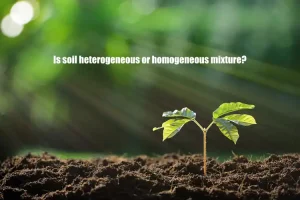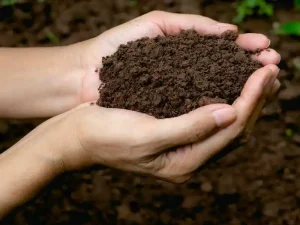Soil is an essential implications for various agricultural, environmental, and engineering applications. Understanding the distribution and characteristics of soil is a natural resource which can help determine its suitability for different land uses and irrigation practices, as well as predict water movement and nutrient availability in the soil. This article will explore whether the soil can be classified as either homogeneous or heterogeneous, its characteristics, and more.

Definition of mixture
A mixture is a fusion of two or additional substances that are not chemically merged. There are two types of mixtures: homogeneous and heterogeneous mixtures.
Some other types of mixtures contain air (a mixture of gases), saltwater (a mix of salt and water), and sugar water (a mixture of sugar and water). These mixtures exhibit varying levels of homogeneity or heterogeneity.
Heterogeneous mixture
A heterogeneous mixture is a mixture where the constituents are not evenly spread across the mixture. In other words, soil is a mixture which has composition and physical properties variations within a given area. This means there are differences in the types and sizes of soil particles and variations in color, texture, and structure. Heterogeneous soil can occur due to rocks, roots, organic matter, or variations in the parent material or geological processes.
Homogeneous mixture
On the other hand, a homogeneous mixture is one in which the components are evenly distributed throughout the variety. In other words, the parts have no visible boundaries and appear as a single phase. Homogeneous soil usually has a uniform color, texture and structure. For example, if you take a sample from one area of homogeneous soil and another piece from a different location, they will have similar characteristics.
Facts about soil
Nature of the soil
Soil comprises different materials and substances that contribute to its overall composition. Soil is made of minerals, organic substances, moisture, and air. These components interact to create a fertile environment for plant growth.
There are other examples of mixtures similar to soil. For instance, a combination of sand and water or a mix of salt and water are heterogeneous mixtures. The components are not uniformly distributed and can be observed separately.
Composition
Soil varies in its composition based on factors such as geographical location, climate, and vegetation. Different types of soil can be found worldwide, each with its unique characteristics. We can mention sandy soil, clay soil, silt soil, loam soil, and peat soil—each type of soil particle in size, water-holding capacity, and nutrient content.
Soil is not a pure substance. A pure substance consists of only one type of particle or molecule, while soil comprises a mixture of different components.
Particles of soil
The particles present in soil, such as minerals and organic matter, contribute to its heterogeneous nature. These particles vary in size, shape, and composition, resulting in a non-uniform distribution throughout the mixture.
There is not a uniform distribution of particles in soil. Soil is a complex mixture where the particles are not evenly distributed throughout. This is because of various processes and factors that affect soil formation. We know that soil is not uniform throughout due to several factors. Geographical location, climate, vegetation, topography, and human activities influence soil formation and composition, resulting in variations and heterogeneity.
Several processes contribute to the heterogeneity of soil. These include physical weathering, chemical weathering, biological activity, erosion, and deposition. Each process impacts the soil composition differently, leading to a non-uniform mixture.
Apart from particles, soil contains other constituents, such as water and air. Water fills the pore spaces between soil particles and is essential for plant growth. Air, on the other hand, provides oxygen for the roots and helps with soil respiration.

Soil classification
Soil a heterogeneous mixture
Yes, soil is considered to be heterogeneous. It comprises various components, such as minerals, organic matter, water, and air, which are not uniformly distributed throughout the soil.
Soil a compound and a mixture
Soil is not a compound but a mixture. A compound is a substance of two or more elements chemically bonded, while a mixture combines different substances that are not chemically bonded.
Soil a homogenous mixture
As mentioned earlier, soil is a heterogeneous mixture. Its components are not evenly distributed throughout the soil, leading to variations in its composition.
Soil is not a homogeneous mixture because its components are not uniformly distributed throughout the soil. Depending on the type of soil and its location, the composition may vary, leading to a heterogeneous mixture.
External factors that affect soil composition
Organic matter, such as decaying plant material and animal waste, is crucial in soil fertility. It enhances soil structure, improves water-holding capacity, and provides essential nutrients for plant growth.
Plants and animals
Plants and living organisms have a significant impact on soil composition. Plant roots help breaking up the soil, allowing better air, water, and nutrients. Through their digging and burrowing activities, animals can mix up different soil layers, leading to a more heterogeneous mixture.
Weather
Weather, especially rainfall and temperature, can significantly impact soil composition. Heavy rain can erode the topsoil, washing away essential nutrients, while extreme temperatures can affect the soil’s microbial activity and decomposition processes.
Chemical processes
Chemical processes such as oxidation, hydrolysis, and carbonation can contribute to soil formation. These processes result in the breakdown of minerals and the release of ions, which can alter the soil’s chemical composition and contribute to its heterogeneity.
Roots of plants
The roots of plants play a crucial role in soil formation. As plants grow, their roots penetrate the soil, breaking it apart and causing mechanical weathering. This process helps to mix different soil particles and minerals, leading to a more heterogeneous mixture.
FAQ
What does heterogeneous mixture mean?
A heterogeneous mixture is a type of mixture where the components are visibly distinct and not evenly distributed throughout the variety.
What does homogeneous mixture mean?
A homogeneous mixture is one where the components are evenly distributed throughout and not visibly distinct.
How is the soil classified?
Soil is primarily considered a heterogeneous mixture due to various components. However, depending on composition and depth, some soil areas may exhibit more homogeneity.
How is soil made?
A mixture of soil is formed through the weathering of rocks, the gradual decomposition of organic matter, and the accumulation of mineral and organic particles over long periods.
Can a mixture be a compound?
No, mixture or compound are two distinct types of substances. A compound is formed through a chemical reaction, while a mixture consists of separate components that can be physically separated.
